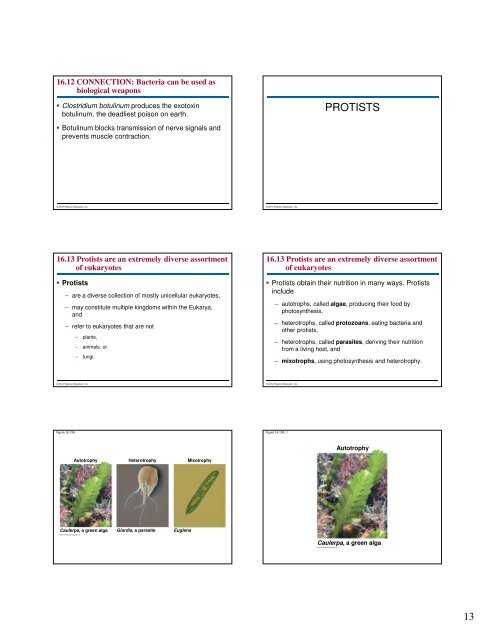Microbial Life: Prokaryotes and Protists - Renz Science
Microbial Life: Prokaryotes and Protists - Renz Science
Microbial Life: Prokaryotes and Protists - Renz Science
Create successful ePaper yourself
Turn your PDF publications into a flip-book with our unique Google optimized e-Paper software.
16.12 CONNECTION: Bacteria can be used asbiological weapons Clostridium botulinum produces the exotoxinbotulinum, the deadliest poison on earth.PROTISTS Botulinum blocks transmission of nerve signals <strong>and</strong>prevents muscle contraction.© 2012 Pearson Education, Inc.© 2012 Pearson Education, Inc.16.13 <strong>Protists</strong> are an extremely diverse assortmentof eukaryotes <strong>Protists</strong>– are a diverse collection of mostly unicellular eukaryotes,– may constitute multiple kingdoms within the Eukarya,<strong>and</strong>– refer to eukaryotes that are not– plants,– animals, or– fungi.16.13 <strong>Protists</strong> are an extremely diverse assortmentof eukaryotes <strong>Protists</strong> obtain their nutrition in many ways. <strong>Protists</strong>include– autotrophs, called algae, producing their food byphotosynthesis,– heterotrophs, called protozoans, eating bacteria <strong>and</strong>other protists,– heterotrophs, called parasites, deriving their nutritionfrom a living host, <strong>and</strong>– mixotrophs, using photosynthesis <strong>and</strong> heterotrophy.© 2012 Pearson Education, Inc.© 2012 Pearson Education, Inc.Figure 16.13AFigure 16.13A_1AutotrophyAutotrophyHeterotrophyMixotrophyCaulerpa, a green algaGiardia, a parasiteEuglenaCaulerpa, a green alga13


